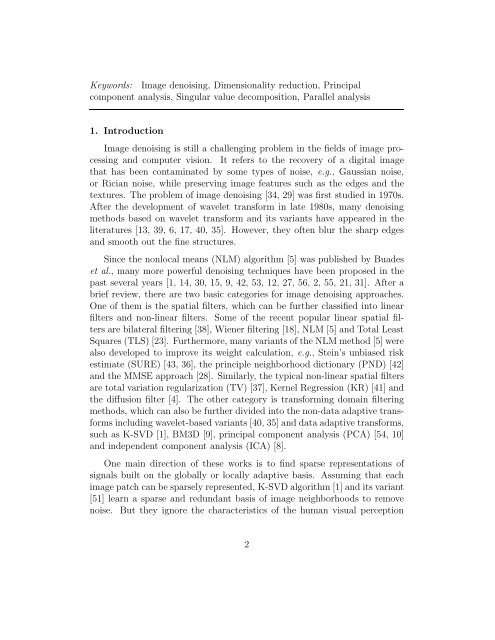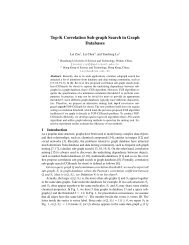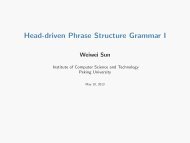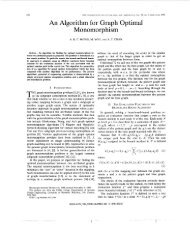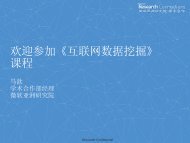Elsevier Editorial System(tm) for Information Sciences Manuscript ...
Elsevier Editorial System(tm) for Information Sciences Manuscript ...
Elsevier Editorial System(tm) for Information Sciences Manuscript ...
Create successful ePaper yourself
Turn your PDF publications into a flip-book with our unique Google optimized e-Paper software.
Keywords: Image denoising, Dimensionality reduction, Principal<br />
component analysis, Singular value decomposition, Parallel analysis<br />
1. Introduction<br />
Image denoising is still a challenging problem in the fields of image processing<br />
and computer vision. It refers to the recovery of a digital image<br />
that has been contaminated by some types of noise, e.g., Gaussian noise,<br />
or Rician noise, while preserving image features such as the edges and the<br />
textures. The problem of image denoising [34, 29] was first studied in 1970s.<br />
After the development of wavelet trans<strong>for</strong>m in late 1980s, many denoising<br />
methods based on wavelet trans<strong>for</strong>m and its variants have appeared in the<br />
literatures [13, 39, 6, 17, 40, 35]. However, they often blur the sharp edges<br />
and smooth out the fine structures.<br />
Since the nonlocal means (NLM) algorithm [5] was published by Buades<br />
et al., many more powerful denoising techniques have been proposed in the<br />
past several years [1, 14, 30, 15, 9, 42, 53, 12, 27, 56, 2, 55, 21, 31]. After a<br />
brief review, there are two basic categories <strong>for</strong> image denoising approaches.<br />
One of them is the spatial filters, which can be further classified into linear<br />
filters and non-linear filters. Some of the recent popular linear spatial filters<br />
are bilateral filtering [38], Wiener filtering [18], NLM [5] and Total Least<br />
Squares(TLS) [23]. Furthermore, manyvariantsoftheNLMmethod[5]were<br />
also developed to improve its weight calculation, e.g., Stein’s unbiased risk<br />
estimate (SURE) [43, 36], the principle neighborhood dictionary (PND) [42]<br />
and the MMSE approach [28]. Similarly, the typical non-linear spatial filters<br />
are total variation regularization (TV) [37], Kernel Regression (KR) [41] and<br />
the diffusion filter [4]. The other category is trans<strong>for</strong>ming domain filtering<br />
methods, which can also be further divided into the non-data adaptive trans<strong>for</strong>msincluding<br />
wavelet-based variants[40, 35] anddataadaptive trans<strong>for</strong>ms,<br />
such as K-SVD [1], BM3D [9], principal component analysis (PCA) [54, 10]<br />
and independent component analysis (ICA) [8].<br />
One main direction of these works is to find sparse representations of<br />
signals built on the globally or locally adaptive basis. Assuming that each<br />
imagepatch canbesparsely represented, K-SVDalgorithm[1]anditsvariant<br />
[51] learn a sparse and redundant basis of image neighborhoods to remove<br />
noise. But they ignore the characteristics of the human visual perception<br />
2


